Examination of Commonwealth Bank’s Share Value and Performance
VerifiedAdded on 2023/06/06
|9
|2607
|197
AI Summary
This report examines the share value of Commonwealth Bank through valuation models such as the constant dividend growth rate model and the comparable approach to valuing the ordinary shares. It analyzes the share value determined for investment purposes and the bank's performance from environmental, social, and governance aspects. The report also discusses the limitations and risks that may affect investment decision making. The subject is business finance theories, and the course code and college/university are not mentioned.
Contribute Materials
Your contribution can guide someone’s learning journey. Share your
documents today.
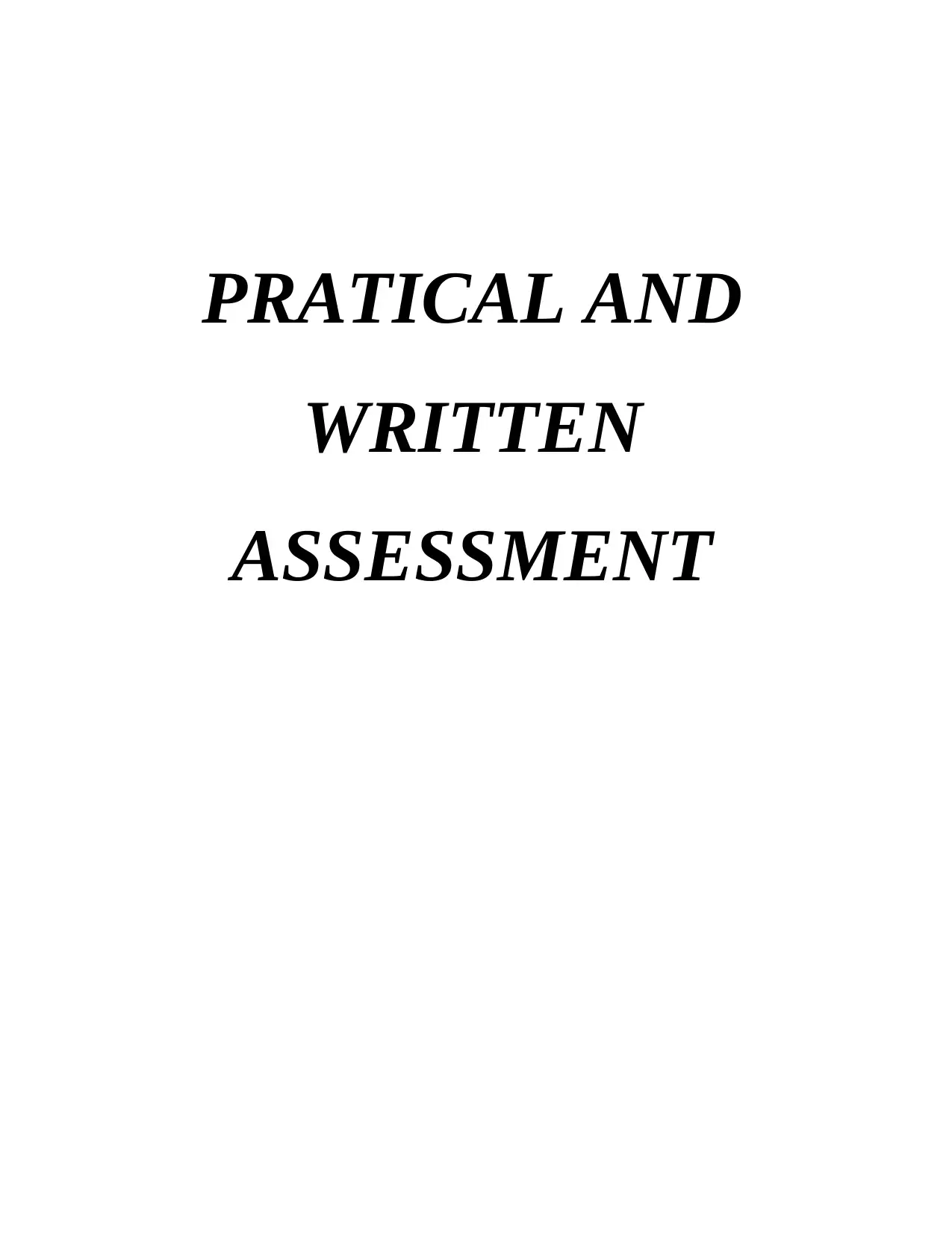
PRATICAL AND
WRITTEN
ASSESSMENT
WRITTEN
ASSESSMENT
Secure Best Marks with AI Grader
Need help grading? Try our AI Grader for instant feedback on your assignments.
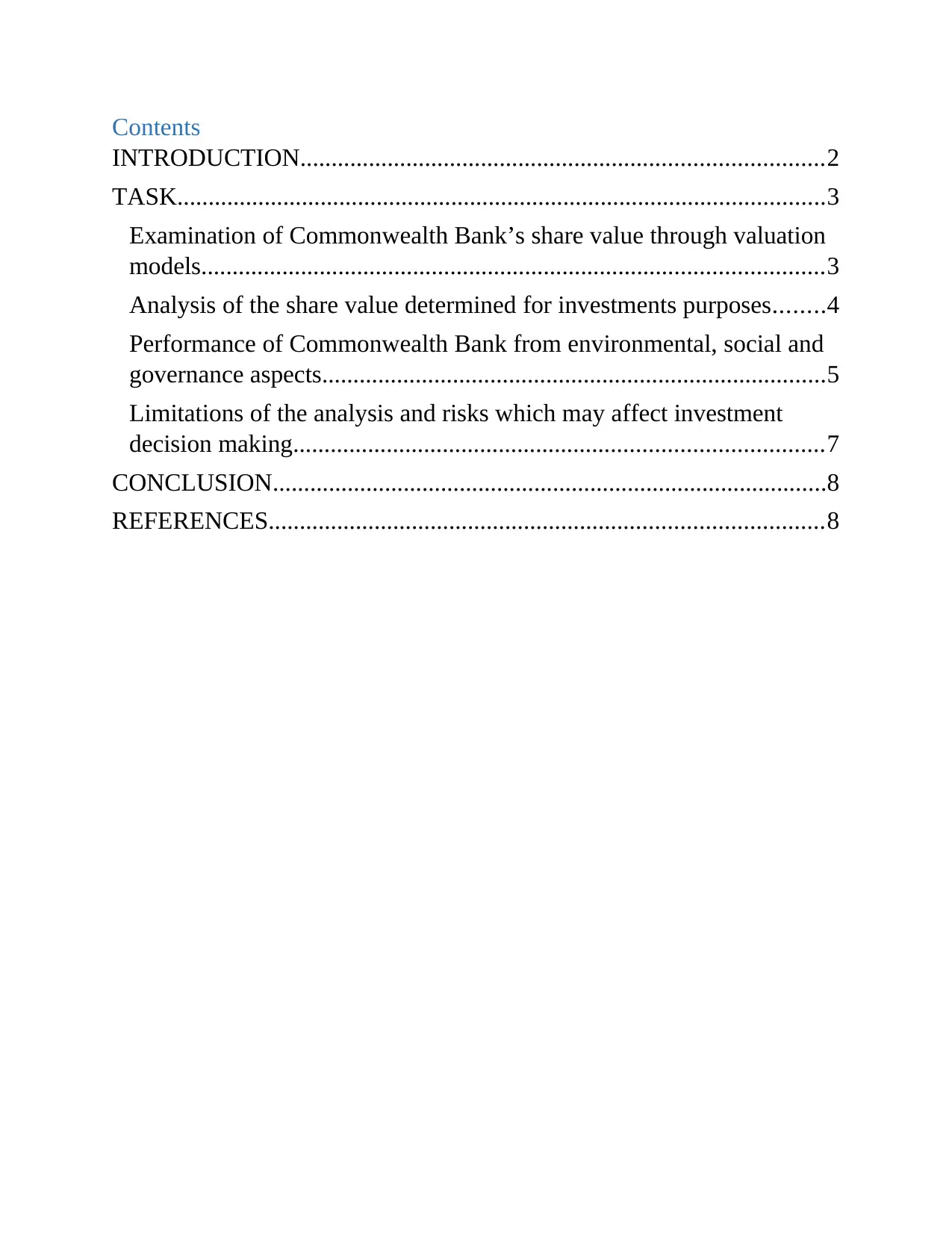
Contents
INTRODUCTION....................................................................................2
TASK........................................................................................................3
Examination of Commonwealth Bank’s share value through valuation
models....................................................................................................3
Analysis of the share value determined for investments purposes........4
Performance of Commonwealth Bank from environmental, social and
governance aspects.................................................................................5
Limitations of the analysis and risks which may affect investment
decision making.....................................................................................7
CONCLUSION.........................................................................................8
REFERENCES.........................................................................................8
INTRODUCTION....................................................................................2
TASK........................................................................................................3
Examination of Commonwealth Bank’s share value through valuation
models....................................................................................................3
Analysis of the share value determined for investments purposes........4
Performance of Commonwealth Bank from environmental, social and
governance aspects.................................................................................5
Limitations of the analysis and risks which may affect investment
decision making.....................................................................................7
CONCLUSION.........................................................................................8
REFERENCES.........................................................................................8
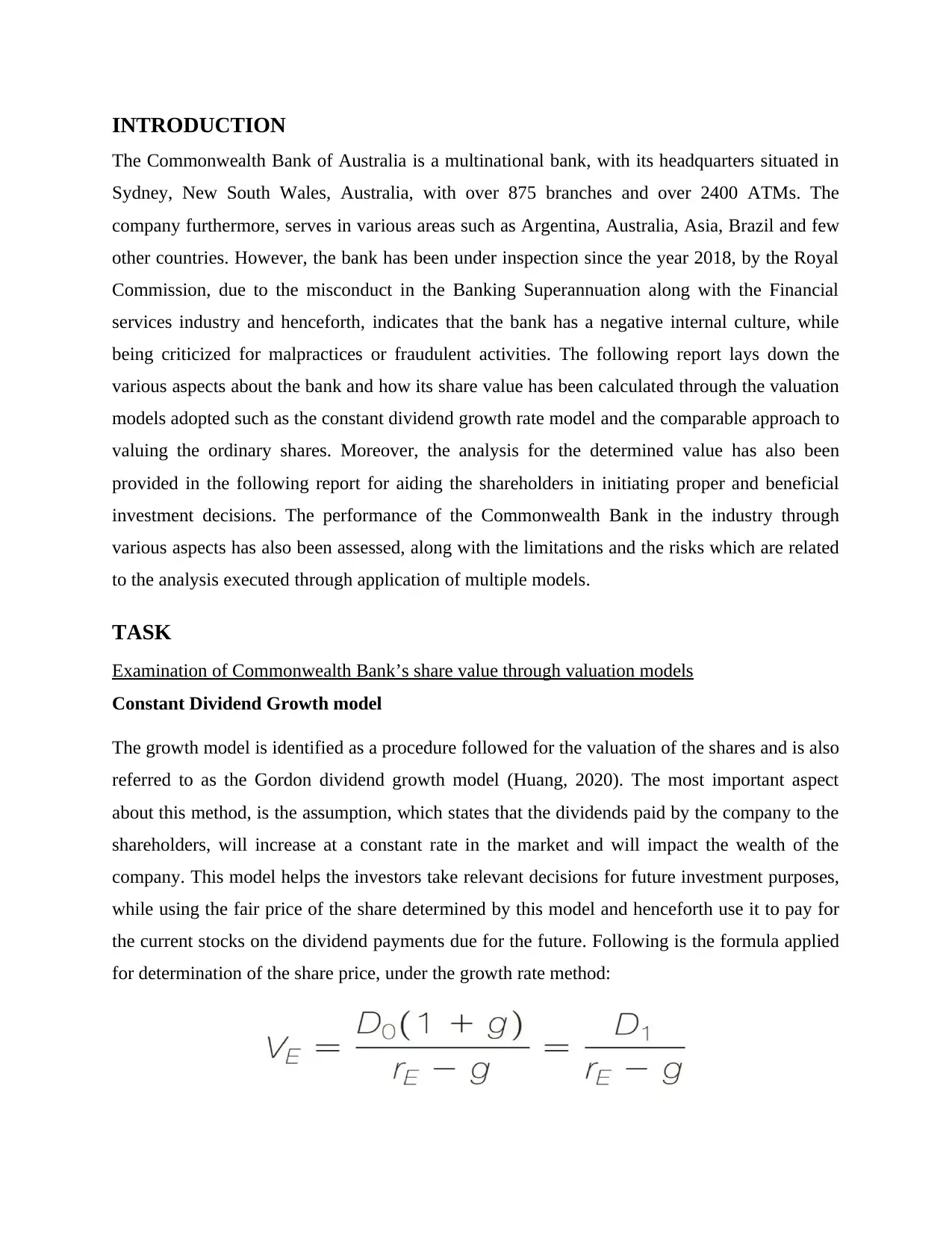
INTRODUCTION
The Commonwealth Bank of Australia is a multinational bank, with its headquarters situated in
Sydney, New South Wales, Australia, with over 875 branches and over 2400 ATMs. The
company furthermore, serves in various areas such as Argentina, Australia, Asia, Brazil and few
other countries. However, the bank has been under inspection since the year 2018, by the Royal
Commission, due to the misconduct in the Banking Superannuation along with the Financial
services industry and henceforth, indicates that the bank has a negative internal culture, while
being criticized for malpractices or fraudulent activities. The following report lays down the
various aspects about the bank and how its share value has been calculated through the valuation
models adopted such as the constant dividend growth rate model and the comparable approach to
valuing the ordinary shares. Moreover, the analysis for the determined value has also been
provided in the following report for aiding the shareholders in initiating proper and beneficial
investment decisions. The performance of the Commonwealth Bank in the industry through
various aspects has also been assessed, along with the limitations and the risks which are related
to the analysis executed through application of multiple models.
TASK
Examination of Commonwealth Bank’s share value through valuation models
Constant Dividend Growth model
The growth model is identified as a procedure followed for the valuation of the shares and is also
referred to as the Gordon dividend growth model (Huang, 2020). The most important aspect
about this method, is the assumption, which states that the dividends paid by the company to the
shareholders, will increase at a constant rate in the market and will impact the wealth of the
company. This model helps the investors take relevant decisions for future investment purposes,
while using the fair price of the share determined by this model and henceforth use it to pay for
the current stocks on the dividend payments due for the future. Following is the formula applied
for determination of the share price, under the growth rate method:
The Commonwealth Bank of Australia is a multinational bank, with its headquarters situated in
Sydney, New South Wales, Australia, with over 875 branches and over 2400 ATMs. The
company furthermore, serves in various areas such as Argentina, Australia, Asia, Brazil and few
other countries. However, the bank has been under inspection since the year 2018, by the Royal
Commission, due to the misconduct in the Banking Superannuation along with the Financial
services industry and henceforth, indicates that the bank has a negative internal culture, while
being criticized for malpractices or fraudulent activities. The following report lays down the
various aspects about the bank and how its share value has been calculated through the valuation
models adopted such as the constant dividend growth rate model and the comparable approach to
valuing the ordinary shares. Moreover, the analysis for the determined value has also been
provided in the following report for aiding the shareholders in initiating proper and beneficial
investment decisions. The performance of the Commonwealth Bank in the industry through
various aspects has also been assessed, along with the limitations and the risks which are related
to the analysis executed through application of multiple models.
TASK
Examination of Commonwealth Bank’s share value through valuation models
Constant Dividend Growth model
The growth model is identified as a procedure followed for the valuation of the shares and is also
referred to as the Gordon dividend growth model (Huang, 2020). The most important aspect
about this method, is the assumption, which states that the dividends paid by the company to the
shareholders, will increase at a constant rate in the market and will impact the wealth of the
company. This model helps the investors take relevant decisions for future investment purposes,
while using the fair price of the share determined by this model and henceforth use it to pay for
the current stocks on the dividend payments due for the future. Following is the formula applied
for determination of the share price, under the growth rate method:
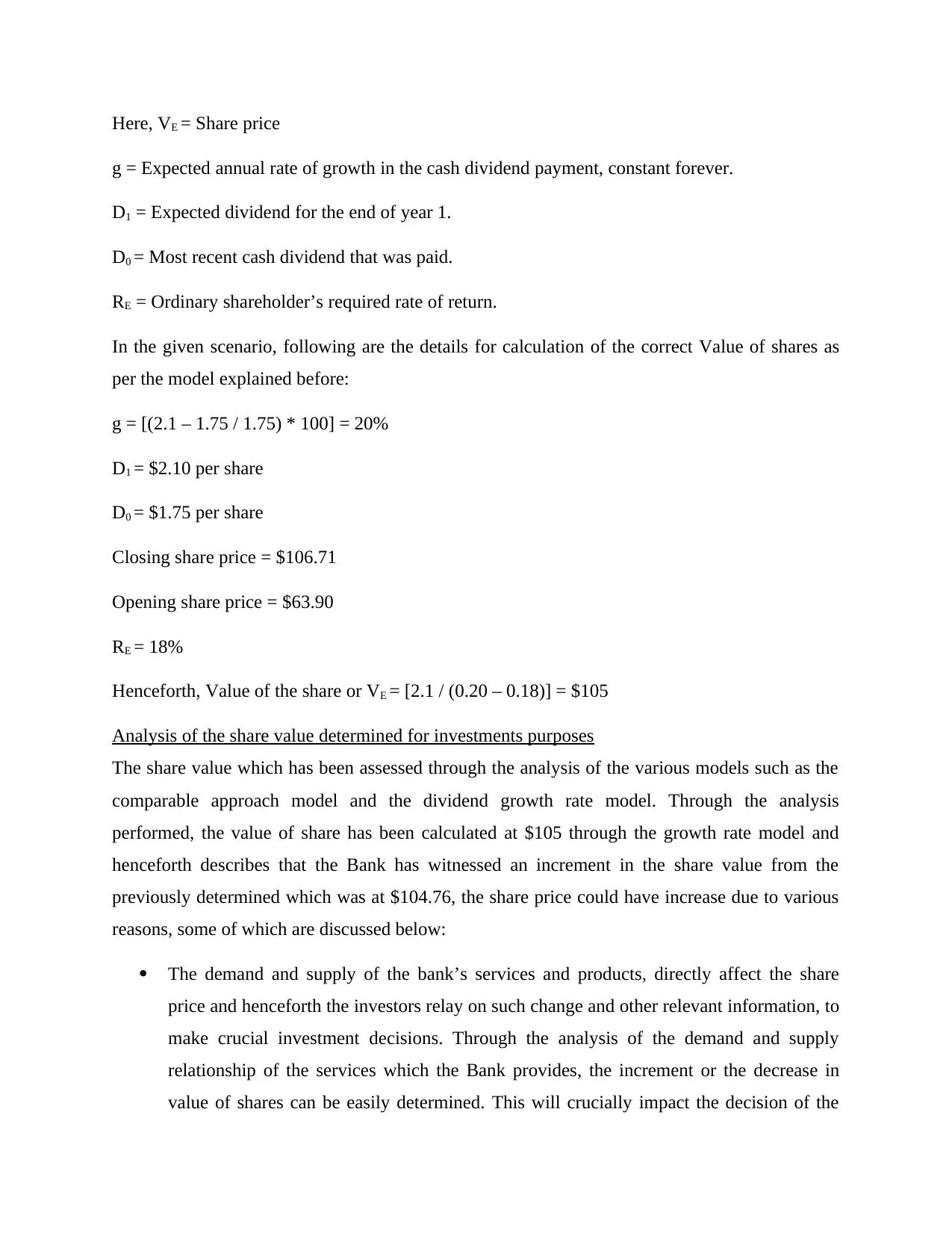
Here, VE = Share price
g = Expected annual rate of growth in the cash dividend payment, constant forever.
D1 = Expected dividend for the end of year 1.
D0 = Most recent cash dividend that was paid.
RE = Ordinary shareholder’s required rate of return.
In the given scenario, following are the details for calculation of the correct Value of shares as
per the model explained before:
g = [(2.1 – 1.75 / 1.75) * 100] = 20%
D1 = $2.10 per share
D0 = $1.75 per share
Closing share price = $106.71
Opening share price = $63.90
RE = 18%
Henceforth, Value of the share or VE = [2.1 / (0.20 – 0.18)] = $105
Analysis of the share value determined for investments purposes
The share value which has been assessed through the analysis of the various models such as the
comparable approach model and the dividend growth rate model. Through the analysis
performed, the value of share has been calculated at $105 through the growth rate model and
henceforth describes that the Bank has witnessed an increment in the share value from the
previously determined which was at $104.76, the share price could have increase due to various
reasons, some of which are discussed below:
The demand and supply of the bank’s services and products, directly affect the share
price and henceforth the investors relay on such change and other relevant information, to
make crucial investment decisions. Through the analysis of the demand and supply
relationship of the services which the Bank provides, the increment or the decrease in
value of shares can be easily determined. This will crucially impact the decision of the
g = Expected annual rate of growth in the cash dividend payment, constant forever.
D1 = Expected dividend for the end of year 1.
D0 = Most recent cash dividend that was paid.
RE = Ordinary shareholder’s required rate of return.
In the given scenario, following are the details for calculation of the correct Value of shares as
per the model explained before:
g = [(2.1 – 1.75 / 1.75) * 100] = 20%
D1 = $2.10 per share
D0 = $1.75 per share
Closing share price = $106.71
Opening share price = $63.90
RE = 18%
Henceforth, Value of the share or VE = [2.1 / (0.20 – 0.18)] = $105
Analysis of the share value determined for investments purposes
The share value which has been assessed through the analysis of the various models such as the
comparable approach model and the dividend growth rate model. Through the analysis
performed, the value of share has been calculated at $105 through the growth rate model and
henceforth describes that the Bank has witnessed an increment in the share value from the
previously determined which was at $104.76, the share price could have increase due to various
reasons, some of which are discussed below:
The demand and supply of the bank’s services and products, directly affect the share
price and henceforth the investors relay on such change and other relevant information, to
make crucial investment decisions. Through the analysis of the demand and supply
relationship of the services which the Bank provides, the increment or the decrease in
value of shares can be easily determined. This will crucially impact the decision of the
Secure Best Marks with AI Grader
Need help grading? Try our AI Grader for instant feedback on your assignments.
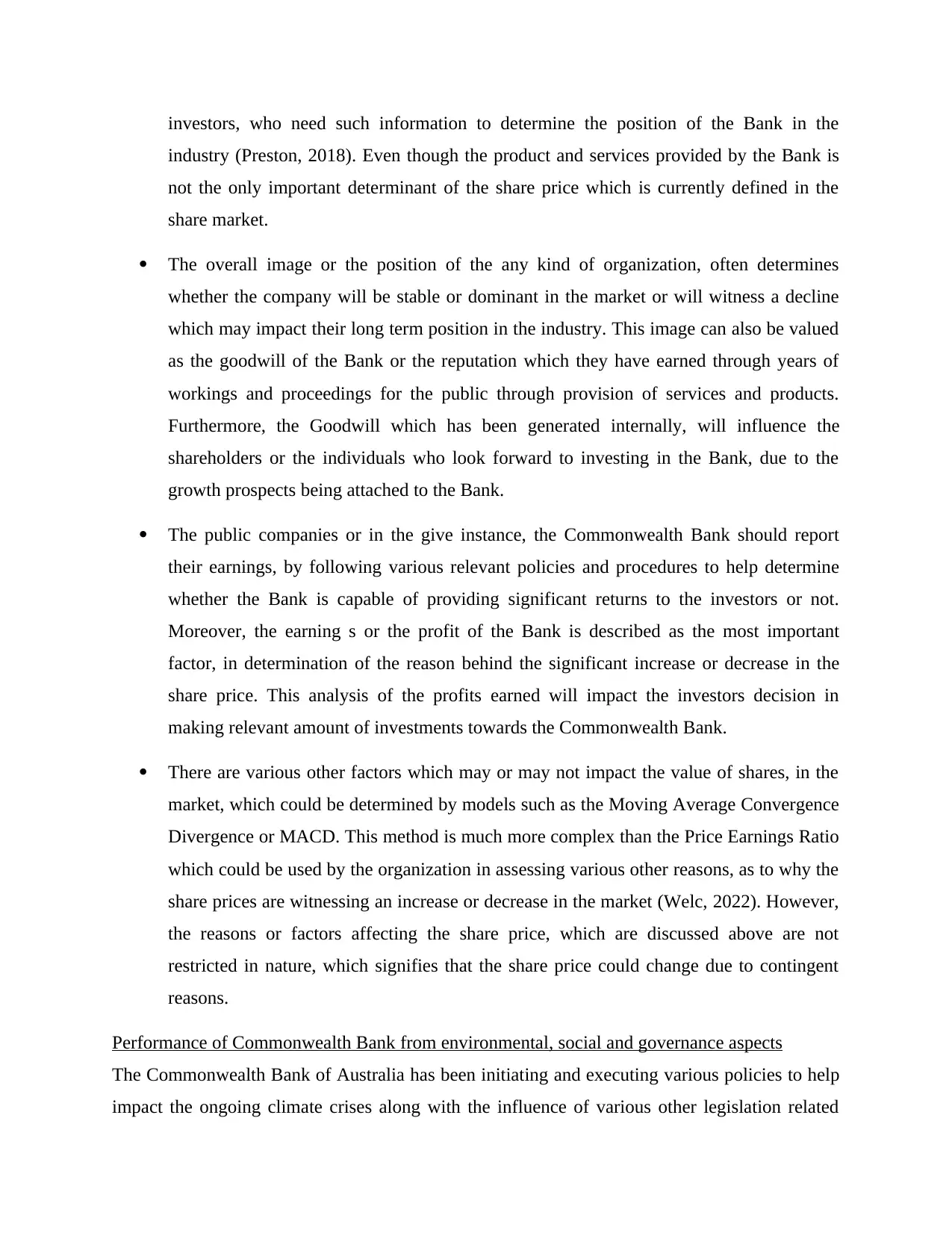
investors, who need such information to determine the position of the Bank in the
industry (Preston, 2018). Even though the product and services provided by the Bank is
not the only important determinant of the share price which is currently defined in the
share market.
The overall image or the position of the any kind of organization, often determines
whether the company will be stable or dominant in the market or will witness a decline
which may impact their long term position in the industry. This image can also be valued
as the goodwill of the Bank or the reputation which they have earned through years of
workings and proceedings for the public through provision of services and products.
Furthermore, the Goodwill which has been generated internally, will influence the
shareholders or the individuals who look forward to investing in the Bank, due to the
growth prospects being attached to the Bank.
The public companies or in the give instance, the Commonwealth Bank should report
their earnings, by following various relevant policies and procedures to help determine
whether the Bank is capable of providing significant returns to the investors or not.
Moreover, the earning s or the profit of the Bank is described as the most important
factor, in determination of the reason behind the significant increase or decrease in the
share price. This analysis of the profits earned will impact the investors decision in
making relevant amount of investments towards the Commonwealth Bank.
There are various other factors which may or may not impact the value of shares, in the
market, which could be determined by models such as the Moving Average Convergence
Divergence or MACD. This method is much more complex than the Price Earnings Ratio
which could be used by the organization in assessing various other reasons, as to why the
share prices are witnessing an increase or decrease in the market (Welc, 2022). However,
the reasons or factors affecting the share price, which are discussed above are not
restricted in nature, which signifies that the share price could change due to contingent
reasons.
Performance of Commonwealth Bank from environmental, social and governance aspects
The Commonwealth Bank of Australia has been initiating and executing various policies to help
impact the ongoing climate crises along with the influence of various other legislation related
industry (Preston, 2018). Even though the product and services provided by the Bank is
not the only important determinant of the share price which is currently defined in the
share market.
The overall image or the position of the any kind of organization, often determines
whether the company will be stable or dominant in the market or will witness a decline
which may impact their long term position in the industry. This image can also be valued
as the goodwill of the Bank or the reputation which they have earned through years of
workings and proceedings for the public through provision of services and products.
Furthermore, the Goodwill which has been generated internally, will influence the
shareholders or the individuals who look forward to investing in the Bank, due to the
growth prospects being attached to the Bank.
The public companies or in the give instance, the Commonwealth Bank should report
their earnings, by following various relevant policies and procedures to help determine
whether the Bank is capable of providing significant returns to the investors or not.
Moreover, the earning s or the profit of the Bank is described as the most important
factor, in determination of the reason behind the significant increase or decrease in the
share price. This analysis of the profits earned will impact the investors decision in
making relevant amount of investments towards the Commonwealth Bank.
There are various other factors which may or may not impact the value of shares, in the
market, which could be determined by models such as the Moving Average Convergence
Divergence or MACD. This method is much more complex than the Price Earnings Ratio
which could be used by the organization in assessing various other reasons, as to why the
share prices are witnessing an increase or decrease in the market (Welc, 2022). However,
the reasons or factors affecting the share price, which are discussed above are not
restricted in nature, which signifies that the share price could change due to contingent
reasons.
Performance of Commonwealth Bank from environmental, social and governance aspects
The Commonwealth Bank of Australia has been initiating and executing various policies to help
impact the ongoing climate crises along with the influence of various other legislation related
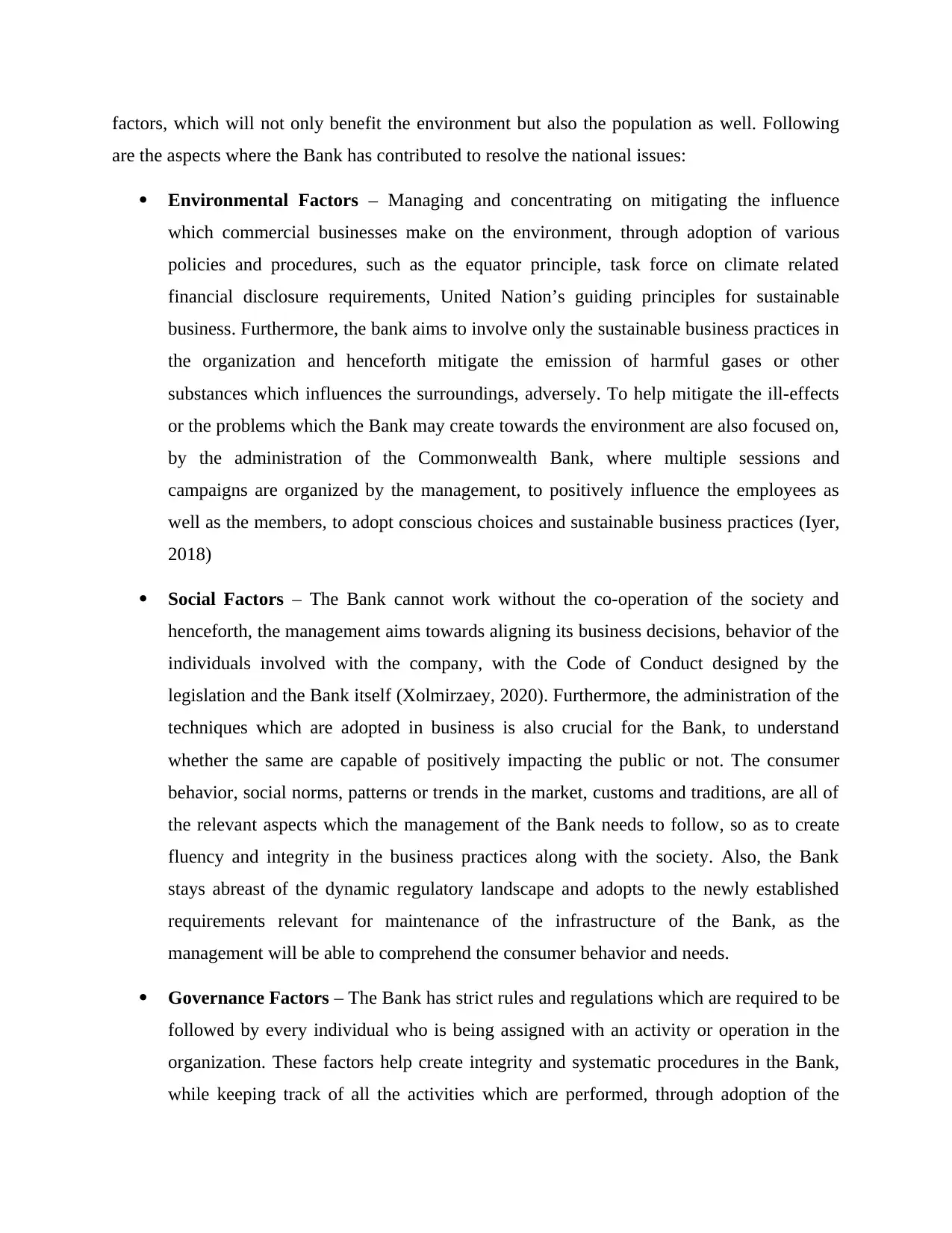
factors, which will not only benefit the environment but also the population as well. Following
are the aspects where the Bank has contributed to resolve the national issues:
Environmental Factors – Managing and concentrating on mitigating the influence
which commercial businesses make on the environment, through adoption of various
policies and procedures, such as the equator principle, task force on climate related
financial disclosure requirements, United Nation’s guiding principles for sustainable
business. Furthermore, the bank aims to involve only the sustainable business practices in
the organization and henceforth mitigate the emission of harmful gases or other
substances which influences the surroundings, adversely. To help mitigate the ill-effects
or the problems which the Bank may create towards the environment are also focused on,
by the administration of the Commonwealth Bank, where multiple sessions and
campaigns are organized by the management, to positively influence the employees as
well as the members, to adopt conscious choices and sustainable business practices (Iyer,
2018)
Social Factors – The Bank cannot work without the co-operation of the society and
henceforth, the management aims towards aligning its business decisions, behavior of the
individuals involved with the company, with the Code of Conduct designed by the
legislation and the Bank itself (Xolmirzaey, 2020). Furthermore, the administration of the
techniques which are adopted in business is also crucial for the Bank, to understand
whether the same are capable of positively impacting the public or not. The consumer
behavior, social norms, patterns or trends in the market, customs and traditions, are all of
the relevant aspects which the management of the Bank needs to follow, so as to create
fluency and integrity in the business practices along with the society. Also, the Bank
stays abreast of the dynamic regulatory landscape and adopts to the newly established
requirements relevant for maintenance of the infrastructure of the Bank, as the
management will be able to comprehend the consumer behavior and needs.
Governance Factors – The Bank has strict rules and regulations which are required to be
followed by every individual who is being assigned with an activity or operation in the
organization. These factors help create integrity and systematic procedures in the Bank,
while keeping track of all the activities which are performed, through adoption of the
are the aspects where the Bank has contributed to resolve the national issues:
Environmental Factors – Managing and concentrating on mitigating the influence
which commercial businesses make on the environment, through adoption of various
policies and procedures, such as the equator principle, task force on climate related
financial disclosure requirements, United Nation’s guiding principles for sustainable
business. Furthermore, the bank aims to involve only the sustainable business practices in
the organization and henceforth mitigate the emission of harmful gases or other
substances which influences the surroundings, adversely. To help mitigate the ill-effects
or the problems which the Bank may create towards the environment are also focused on,
by the administration of the Commonwealth Bank, where multiple sessions and
campaigns are organized by the management, to positively influence the employees as
well as the members, to adopt conscious choices and sustainable business practices (Iyer,
2018)
Social Factors – The Bank cannot work without the co-operation of the society and
henceforth, the management aims towards aligning its business decisions, behavior of the
individuals involved with the company, with the Code of Conduct designed by the
legislation and the Bank itself (Xolmirzaey, 2020). Furthermore, the administration of the
techniques which are adopted in business is also crucial for the Bank, to understand
whether the same are capable of positively impacting the public or not. The consumer
behavior, social norms, patterns or trends in the market, customs and traditions, are all of
the relevant aspects which the management of the Bank needs to follow, so as to create
fluency and integrity in the business practices along with the society. Also, the Bank
stays abreast of the dynamic regulatory landscape and adopts to the newly established
requirements relevant for maintenance of the infrastructure of the Bank, as the
management will be able to comprehend the consumer behavior and needs.
Governance Factors – The Bank has strict rules and regulations which are required to be
followed by every individual who is being assigned with an activity or operation in the
organization. These factors help create integrity and systematic procedures in the Bank,
while keeping track of all the activities which are performed, through adoption of the
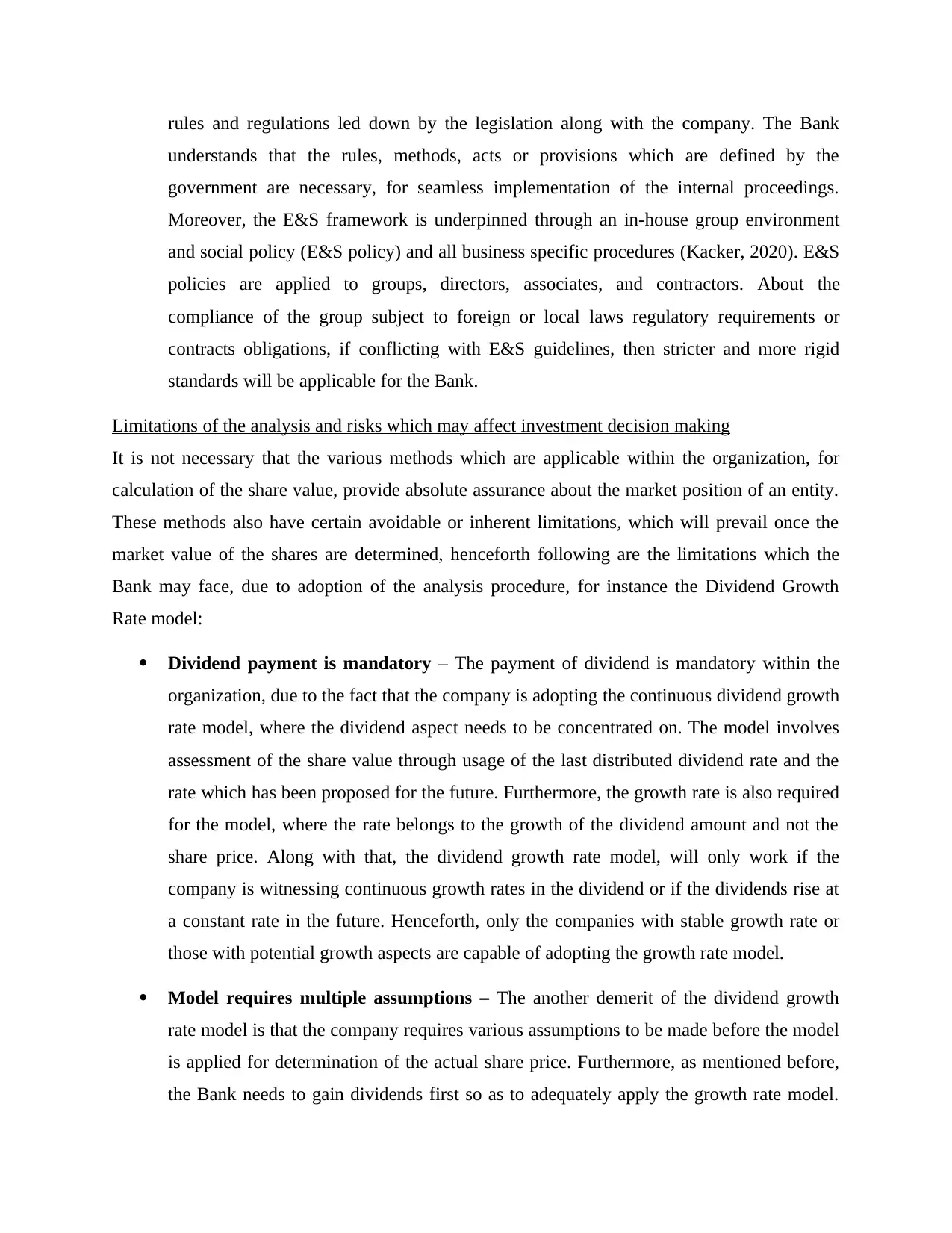
rules and regulations led down by the legislation along with the company. The Bank
understands that the rules, methods, acts or provisions which are defined by the
government are necessary, for seamless implementation of the internal proceedings.
Moreover, the E&S framework is underpinned through an in-house group environment
and social policy (E&S policy) and all business specific procedures (Kacker, 2020). E&S
policies are applied to groups, directors, associates, and contractors. About the
compliance of the group subject to foreign or local laws regulatory requirements or
contracts obligations, if conflicting with E&S guidelines, then stricter and more rigid
standards will be applicable for the Bank.
Limitations of the analysis and risks which may affect investment decision making
It is not necessary that the various methods which are applicable within the organization, for
calculation of the share value, provide absolute assurance about the market position of an entity.
These methods also have certain avoidable or inherent limitations, which will prevail once the
market value of the shares are determined, henceforth following are the limitations which the
Bank may face, due to adoption of the analysis procedure, for instance the Dividend Growth
Rate model:
Dividend payment is mandatory – The payment of dividend is mandatory within the
organization, due to the fact that the company is adopting the continuous dividend growth
rate model, where the dividend aspect needs to be concentrated on. The model involves
assessment of the share value through usage of the last distributed dividend rate and the
rate which has been proposed for the future. Furthermore, the growth rate is also required
for the model, where the rate belongs to the growth of the dividend amount and not the
share price. Along with that, the dividend growth rate model, will only work if the
company is witnessing continuous growth rates in the dividend or if the dividends rise at
a constant rate in the future. Henceforth, only the companies with stable growth rate or
those with potential growth aspects are capable of adopting the growth rate model.
Model requires multiple assumptions – The another demerit of the dividend growth
rate model is that the company requires various assumptions to be made before the model
is applied for determination of the actual share price. Furthermore, as mentioned before,
the Bank needs to gain dividends first so as to adequately apply the growth rate model.
understands that the rules, methods, acts or provisions which are defined by the
government are necessary, for seamless implementation of the internal proceedings.
Moreover, the E&S framework is underpinned through an in-house group environment
and social policy (E&S policy) and all business specific procedures (Kacker, 2020). E&S
policies are applied to groups, directors, associates, and contractors. About the
compliance of the group subject to foreign or local laws regulatory requirements or
contracts obligations, if conflicting with E&S guidelines, then stricter and more rigid
standards will be applicable for the Bank.
Limitations of the analysis and risks which may affect investment decision making
It is not necessary that the various methods which are applicable within the organization, for
calculation of the share value, provide absolute assurance about the market position of an entity.
These methods also have certain avoidable or inherent limitations, which will prevail once the
market value of the shares are determined, henceforth following are the limitations which the
Bank may face, due to adoption of the analysis procedure, for instance the Dividend Growth
Rate model:
Dividend payment is mandatory – The payment of dividend is mandatory within the
organization, due to the fact that the company is adopting the continuous dividend growth
rate model, where the dividend aspect needs to be concentrated on. The model involves
assessment of the share value through usage of the last distributed dividend rate and the
rate which has been proposed for the future. Furthermore, the growth rate is also required
for the model, where the rate belongs to the growth of the dividend amount and not the
share price. Along with that, the dividend growth rate model, will only work if the
company is witnessing continuous growth rates in the dividend or if the dividends rise at
a constant rate in the future. Henceforth, only the companies with stable growth rate or
those with potential growth aspects are capable of adopting the growth rate model.
Model requires multiple assumptions – The another demerit of the dividend growth
rate model is that the company requires various assumptions to be made before the model
is applied for determination of the actual share price. Furthermore, as mentioned before,
the Bank needs to gain dividends first so as to adequately apply the growth rate model.
Paraphrase This Document
Need a fresh take? Get an instant paraphrase of this document with our AI Paraphraser
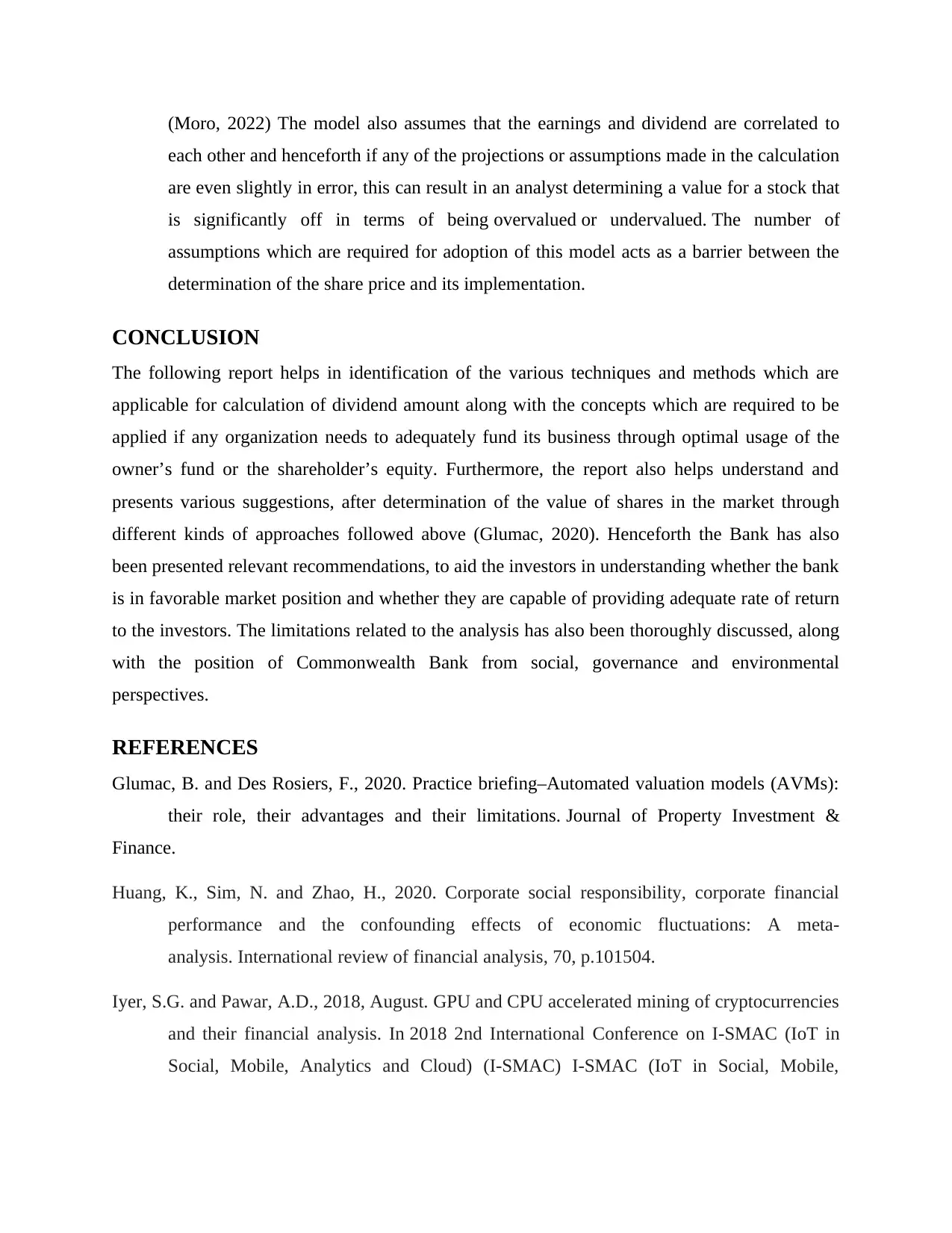
(Moro, 2022) The model also assumes that the earnings and dividend are correlated to
each other and henceforth if any of the projections or assumptions made in the calculation
are even slightly in error, this can result in an analyst determining a value for a stock that
is significantly off in terms of being overvalued or undervalued. The number of
assumptions which are required for adoption of this model acts as a barrier between the
determination of the share price and its implementation.
CONCLUSION
The following report helps in identification of the various techniques and methods which are
applicable for calculation of dividend amount along with the concepts which are required to be
applied if any organization needs to adequately fund its business through optimal usage of the
owner’s fund or the shareholder’s equity. Furthermore, the report also helps understand and
presents various suggestions, after determination of the value of shares in the market through
different kinds of approaches followed above (Glumac, 2020). Henceforth the Bank has also
been presented relevant recommendations, to aid the investors in understanding whether the bank
is in favorable market position and whether they are capable of providing adequate rate of return
to the investors. The limitations related to the analysis has also been thoroughly discussed, along
with the position of Commonwealth Bank from social, governance and environmental
perspectives.
REFERENCES
Glumac, B. and Des Rosiers, F., 2020. Practice briefing–Automated valuation models (AVMs):
their role, their advantages and their limitations. Journal of Property Investment &
Finance.
Huang, K., Sim, N. and Zhao, H., 2020. Corporate social responsibility, corporate financial
performance and the confounding effects of economic fluctuations: A meta-
analysis. International review of financial analysis, 70, p.101504.
Iyer, S.G. and Pawar, A.D., 2018, August. GPU and CPU accelerated mining of cryptocurrencies
and their financial analysis. In 2018 2nd International Conference on I-SMAC (IoT in
Social, Mobile, Analytics and Cloud) (I-SMAC) I-SMAC (IoT in Social, Mobile,
each other and henceforth if any of the projections or assumptions made in the calculation
are even slightly in error, this can result in an analyst determining a value for a stock that
is significantly off in terms of being overvalued or undervalued. The number of
assumptions which are required for adoption of this model acts as a barrier between the
determination of the share price and its implementation.
CONCLUSION
The following report helps in identification of the various techniques and methods which are
applicable for calculation of dividend amount along with the concepts which are required to be
applied if any organization needs to adequately fund its business through optimal usage of the
owner’s fund or the shareholder’s equity. Furthermore, the report also helps understand and
presents various suggestions, after determination of the value of shares in the market through
different kinds of approaches followed above (Glumac, 2020). Henceforth the Bank has also
been presented relevant recommendations, to aid the investors in understanding whether the bank
is in favorable market position and whether they are capable of providing adequate rate of return
to the investors. The limitations related to the analysis has also been thoroughly discussed, along
with the position of Commonwealth Bank from social, governance and environmental
perspectives.
REFERENCES
Glumac, B. and Des Rosiers, F., 2020. Practice briefing–Automated valuation models (AVMs):
their role, their advantages and their limitations. Journal of Property Investment &
Finance.
Huang, K., Sim, N. and Zhao, H., 2020. Corporate social responsibility, corporate financial
performance and the confounding effects of economic fluctuations: A meta-
analysis. International review of financial analysis, 70, p.101504.
Iyer, S.G. and Pawar, A.D., 2018, August. GPU and CPU accelerated mining of cryptocurrencies
and their financial analysis. In 2018 2nd International Conference on I-SMAC (IoT in
Social, Mobile, Analytics and Cloud) (I-SMAC) I-SMAC (IoT in Social, Mobile,
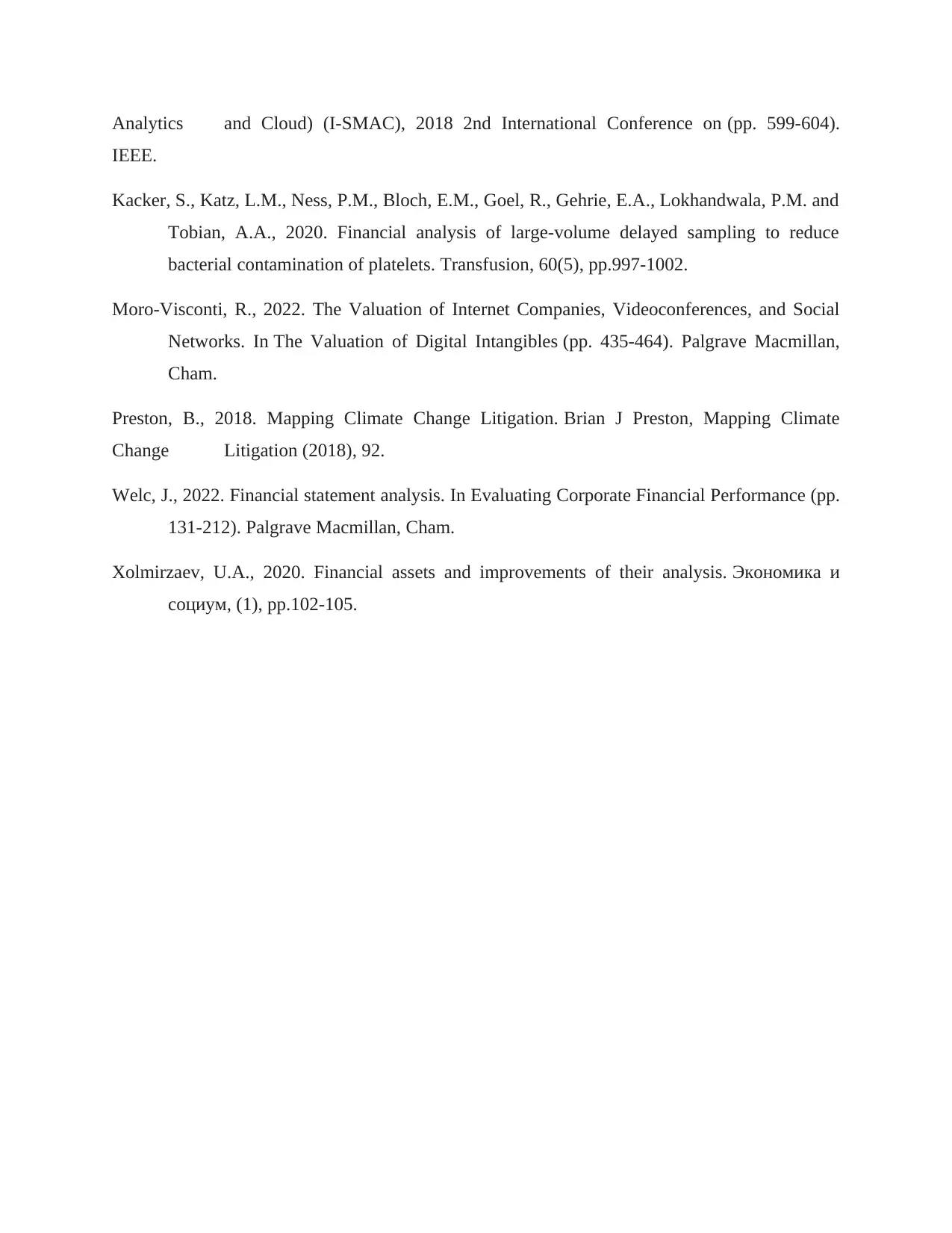
Analytics and Cloud) (I-SMAC), 2018 2nd International Conference on (pp. 599-604).
IEEE.
Kacker, S., Katz, L.M., Ness, P.M., Bloch, E.M., Goel, R., Gehrie, E.A., Lokhandwala, P.M. and
Tobian, A.A., 2020. Financial analysis of large‐volume delayed sampling to reduce
bacterial contamination of platelets. Transfusion, 60(5), pp.997-1002.
Moro-Visconti, R., 2022. The Valuation of Internet Companies, Videoconferences, and Social
Networks. In The Valuation of Digital Intangibles (pp. 435-464). Palgrave Macmillan,
Cham.
Preston, B., 2018. Mapping Climate Change Litigation. Brian J Preston, Mapping Climate
Change Litigation (2018), 92.
Welc, J., 2022. Financial statement analysis. In Evaluating Corporate Financial Performance (pp.
131-212). Palgrave Macmillan, Cham.
Xolmirzaev, U.A., 2020. Financial assets and improvements of their analysis. Экономика и
социум, (1), pp.102-105.
IEEE.
Kacker, S., Katz, L.M., Ness, P.M., Bloch, E.M., Goel, R., Gehrie, E.A., Lokhandwala, P.M. and
Tobian, A.A., 2020. Financial analysis of large‐volume delayed sampling to reduce
bacterial contamination of platelets. Transfusion, 60(5), pp.997-1002.
Moro-Visconti, R., 2022. The Valuation of Internet Companies, Videoconferences, and Social
Networks. In The Valuation of Digital Intangibles (pp. 435-464). Palgrave Macmillan,
Cham.
Preston, B., 2018. Mapping Climate Change Litigation. Brian J Preston, Mapping Climate
Change Litigation (2018), 92.
Welc, J., 2022. Financial statement analysis. In Evaluating Corporate Financial Performance (pp.
131-212). Palgrave Macmillan, Cham.
Xolmirzaev, U.A., 2020. Financial assets and improvements of their analysis. Экономика и
социум, (1), pp.102-105.
1 out of 9
Related Documents
Your All-in-One AI-Powered Toolkit for Academic Success.
+13062052269
info@desklib.com
Available 24*7 on WhatsApp / Email
![[object Object]](/_next/static/media/star-bottom.7253800d.svg)
Unlock your academic potential
© 2024 | Zucol Services PVT LTD | All rights reserved.





